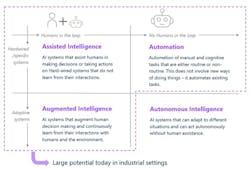Artificial intelligence (AI) is transforming industry by enabling computers to emulate human intelligence. Recently, the capabilities of large language models (LLMs), such as OpenAI’s ChatGPT, have raised excitement and expectations about AI’s potential for the process manufacturing industry. While the advancements of generative AI are remarkable, manufacturers must distinguish hype from practical applications.
In the context of industrial operations, LLMs already can be used to help engineers and data scientists perform daily tasks. They can help with natural or computer languages, integrate with external data sources and work with other solutions. Practical applications, such as the creation of machine learning (ML) models and dashboards, are emerging.
These applications also provide a foundation for future advancements in AI for industry. However, there are challenges to consider. Process manufacturers need to approach AI with a balanced perspective and clear understanding of how it will address specific industry needs. They also must understand that collaboration is essential between AI technologies and the users they assist.
The basics of industrial AI
There are four categories of industrial AI (Figure 1). They include solutions that are hardwired to run certain tasks as well as those that adapt as they learn. Each category represents a different level of interaction between machines and their human counterparts, along with the type of decisions the machine can make on its own.
- Assisted intelligence: This is the most basic form of AI. It assists operational experts with tasks, but it does not make decisions independently. These solutions can be trained with operational data. Therefore, they might suggest a course of action based on available information, but the final decision is up to the engineer.
- Automated intelligence: Here, AI takes a more active role by automating routine tasks. It follows predefined rules and procedures, which reduces human intervention in mundane activities. Automated intelligence is commonly seen in robotic processes, such as a machine that sorts material or products on a conveyor belt.
- Augmented intelligence: This type of AI represents collaborative interaction between humans and systems. Augmented intelligence solutions are capable of analyzing operational data and making recommendations. They help engineers make data-driven decisions.
- Autonomous intelligence: The most advanced category, autonomous intelligence, is where AI systems operate independently. These solutions are not yet appropriate for managing manufacturing processes.
Generative AI emerges
Although the algorithms that enable AI have been used in computers since the 1950s, the rise of LLMs — propelled by ChatGPT — has recently thrust AI into the spotlight. Often called Generative AI, these LLMs understand both natural and computer languages. Their primary purpose is to generate contextually relevant content, which opens opportunities for new use cases in almost every industry.
Market research analysts, such as Gartner, have monitored the evolution and expectations surrounding AI solutions. According to the 2023 Gartner Hype Cycle, Generative AI has reached the peak of inflated expectations. This signifies the immense anticipation surrounding its capabilities.
A survey released in November by the U.S. Census shows that future adoption of AI is expected to grow rapidly even among industries where current use remains low. In July 2023, Forrester revealed that 67% of businesses have been actively exploring ways to integrate generative AI into their strategic frameworks. Furthermore, Forrester highlighted the significance of technical experimentation as organizations transition into 2024.
The risks and benefits of AI for industry
The process manufacturing industry is still in the experimental phase of AI. Companies are learning how and where the benefits of these solutions outweigh the potential risks. The industry is proceeding with caution because manufacturing processes still require the decision-making skills of an engineer.
Testing Generative AI in process manufacturing environments carries inherent risks, which includes the potential for Generative AI “hallucinations.” These are errors that an LLM can introduce into the generated information. In a process manufacturing environment, these errors also pose threats to equipment integrity, safety and even lives.
Nevertheless, companies have already started using AI. Use cases for LLMs include coding assistance for creating ML models or other tasks that require computer languages. They also can store and retrieve information, so they can be used as a repository for use cases and corresponding prescriptive information that can be found and extracted with a natural language prompt. In yet another example, the LLMs could aid in the creation of more personalized operational dashboards to service thousands of users.
Even more can be accomplished when Generative AI is used with other technology. With the incorporation of Retrieval Augmented Generation (RAG), chatbots can be added to these databases. Through API calls, engineers can access advanced industrial analytics software and interact with it directly. They can simply inquire, “What has happened since my last shift?" The RAG-enabled GPT then generates a detailed summary of events from that time frame.
Overcoming initial challenges
Still, implementing AI comes with a set of unique challenges. The most significant is the quality and integrity of data. AI systems are only as effective as the data they process. Inaccurate or incomplete data can lead to flawed insights and decision-making. Therefore, emphasis must be placed on making the right kind of data available to these solutions.
Another challenge is managing change. This includes not only the technical aspects of integrating AI into existing systems but also addressing organizational and cultural shifts. Employees need to be trained and prepared for new workflows and decision-making processes that come with AI integration.
The journey toward AI is marked by these and other challenges that must be addressed before reaching the next level of analytics maturity. As shown in Figure 2, the transition requires a shift from traditional operational approaches to more data-centric strategies. It involves not just adopting new technologies but breaking down silos and fostering a culture that values data-driven decision-making and continuous learning.
With the rise of data lakes and modern, cloud-based historians, the availability of time-series and contextual data across sites and to remote workers has improved. The rise in available data will also help companies adopt AI solutions more rapidly.
AI in use: Anomaly detection
Anomaly detection is frequently mentioned as a use case for AI. However, there are many ways to detect anomalies. Those include solutions that do not require the use of AI.
For example, operational experts can conduct a value-based search of time-series data to find outliers from expected patterns. These outliers are presented in a comprehensible manner, which allows for quick response and decision-making. Creating a golden fingerprint of ideal batch parameters from contextual data helps define an anomaly and aids in their detection. In more advanced scenarios, the application of a self-organizing map (SOM) develops models that are capable of finding both global and local outliers within a multivariate context.
At specialty chemical company Clariant, process engineers learned the benefits of using advanced techniques for anomaly detection. From operational data processed through advanced industrial analytics software, Clariant’s data scientists developed models that included soft sensors, anomaly detection scoring, and predictive maintenance alerts.
The integration of these machine learning capabilities empowered Clariant to achieve substantial operational improvements. Notably, the company recorded a 10% reduction in batch processing time, or the equivalent of one batch a day. Moreover, the enhancements in operational efficiency led to a 9% reduction in energy consumption.
The Future of AI for industry
AI is steadily gaining ground, with technological advancements occurring daily. However, its implementation often demands a substantial investment for little return in value.
By tapping into the wealth of data that is already available, engineers can add immediate insights to optimize operations. Meanwhile, they are taking many of the steps necessary for a successful future with AI.
Rob Azevedo is Senior Product Manager & Strategic Alliances at TrendMiner. He leads the strategy for growth of the analytics and reporting platforms. Based out of Belgium, Rob has more than 11 years of experience in building high-performant and highly available B2B and B2C software.
TrendMiner




